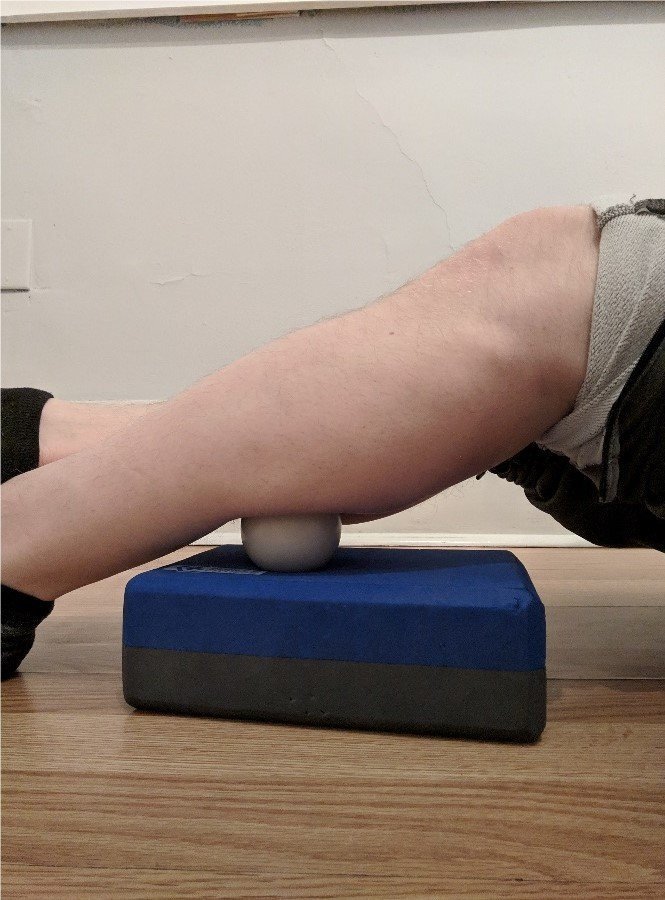Self-care for runners
Steady self-care can help improve range of motion, decrease pain and stiffness, increase your endurance, and it can help prevent common injuries.
Developing a self-care routine is an integral part of any training plan. Steady self-care can help improve your range of motion, decrease pain and stiffness, increase your endurance, and it can help prevent common injuries. On the following pages, I will introduce you to some self-care exercises to help loosen up your feet, legs, and hips in order to keep you running at your best.
Palmar surface of the foot:
1. Stand erect with one hand on a table or something stable to maintain your balance.
2. Begin with your lacrosse ball below the ball of your foot on the pinky toe side.
3. Take a few deep breaths to slowly relax your foot into the ball, maintain this pace of breath the whole time.
4. Work your way over toward your big toe side, slowly rolling the ball up and down under your foot.
5. Move the ball to the arch of your foot, just below the big toe, slowly begin working the ball down toward your heel, using a back and forth motion.
6. Move the ball to the pinky toe side, the outer arch of your foot.
7. Repeat the same back and forth motion you used on the inner arch, moving up toward the ball of your foot again.
8. Repeat on the other foot.
Calf muscles:
1. Place your ball on a yoga block, or on a flat, stable surface.
2. Rest your leg on the ball, beginning at the top of the Achilles tendon.
3. Rest your other leg on top of the leg to be worked on, remembering to breathe deeply into the motion(you do not need any pressure, just rest the leg there).
4. Begin slowly working the ball in a back and forth motion, you can breathe for a few second into any spots that are particularly troublesome.
5. Work your way directly up the center of the calf muscles, being sure to notice and trouble areas.
6. Repeat on the other leg.
Hamstrings:
1. Sitting upright on the floor, rest the ball under your thigh at point A.
2. Place your other leg on top of this leg, as done with the calf muscle section.
3. Breathe into the pressure, allowing yourself to relax and focus.
4. Begin to work your way up toward point B in a back and forth motion, remembering to stop and any troublesome spots.
5. Once up to point B, find the hamstring origin(just under your ischial tuberosity), and rest there for a few deep breaths.
6. Repeat on the other leg.
Glutes:
1. Sit upright with your target leg in a butterfly position and the other foot flat on the floor for control and stability.
2. Place the ball under point A, remembering to breathe into the pressure.
3. Move your body slowly backward, so that the ball follows along the edge of the sacrum.
4. Move back up to point A, resting on any trouble points.
5. Move your body slowly, allowing the ball to follow along the back of your hip bone, toward point B, resting for a few breaths here.
6. Move the ball down toward point C, resting here for a moment.
7. Move the ball from here, back up toward the center of the sacrum.
8. Repeat on the other leg.
Quads:
1. Lie face down with your target leg straight and your other leg in a lunge position for stability.
2. Begin with the ball at point A, just above the patella. Try to slowly flex and extend your knee to loosen up this dense connective tissue, remembering to breathe slowly and deeply into the pressure.
3. Move the ball up toward point B, in a slow back and forth motion, if you can.
4. Rest here for a few deep breaths before moving up to point C, in the same back and forth motion.
5. Once at point C, Just below your hip bone, rest here and try to flex and extend your knee again to loosen up the tissue.
6. Repeat on the other leg.






